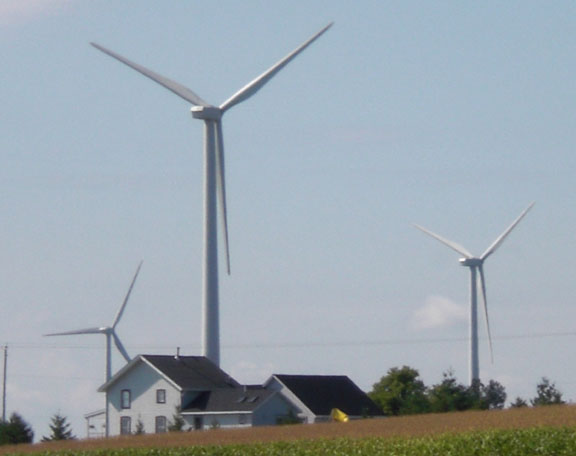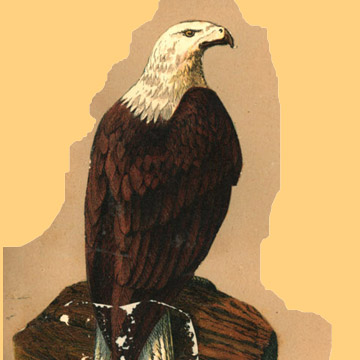Entries in wind farm bird (2)
8/8/11 Big Wind tears up birds and bats AND Big Wind tears up little town of Walnut
 As many parts of the world continue to push for alternate energy sources and less dependence on oil, there is rising concern that wind energy is actually not too good for the environment. The fact that wind farms can generate electricity without producing any emissions often overshadows its problems, such as the number of birds and other flying animals killed or injured from colliding with wind turbines and its physical appearance and noise that many people consider to be bothersome.
As many parts of the world continue to push for alternate energy sources and less dependence on oil, there is rising concern that wind energy is actually not too good for the environment. The fact that wind farms can generate electricity without producing any emissions often overshadows its problems, such as the number of birds and other flying animals killed or injured from colliding with wind turbines and its physical appearance and noise that many people consider to be bothersome.
For instance, a wind farm in Southern California could be facing legal issues. Because of the increasing death rate of birds near the facility, investigations have begun recently on the Pine Tree Wind Project headed by Los Angeles Department of Water and Power.
The 120-megawatt facility occupies 8,000 acres of land in the Tehachapi Mountains and is blamed for the deaths of many migratory birds, including a number of endangered golden eagles which are protected under the Endangered Species Act and could make Pine Tree the first ever wind farm to be charged under the Act.
In June 2010, the DWP conducted an internal study and concluded that the death rates of birds at Pine Tree were “relatively high” compared with 45 other wind energy plants in the country.
Other than activists, residents also have complaints with wind turbines. With blades that can be as long as a football field, many consider them to be a huge eyesore. Additionally, they generate a considerable amount of noise.
In the Bay Area, wind turbines also have a bad image to animal activists and residents. Providing thousands of nearby homes with clean, wind generated electricity since the 1980s, the Altamont Pass Wind Resource Area also causes a significant amount of bird deaths. Having 5,000 wind turbines, the wind farm at Altamont Pass causes about 67 golden eagle deaths a year. However, the much smaller Pine Tree wind farm and its 90 turbines has a higher death rate per turbine; about 3 times greater than the Altamont Pass wind farm.
Although high bird mortality rates is one of the most detrimental impacts wind turbines have, governments have been rather slow to address the problem. Says Shawn Smallwood, an expert on raptor ecology, "Wind farms have been killing birds for decades and law enforcement has done nothing about it." Perhaps the reason for the government's slow action is the push for renewable energy sources. In April, California governor Jerry Brown passed a law requiring a third of electricity used in the state to come from renewable sources, including wind, by 2020. The new law is the most aggressive of any state in the US.
A possible solution to ease the damage to migrating birds is to shut down wind farms during migrating seasons. TransAlta Corpopration in Ontario, Canada has been urged by activists to turn off wind turbines during the summer and early fall, which are considered “high-risk periods.” Says Ted Cheskey, of Nature Canada,“That period is when the vast majority of birds seem to be killed. The evidence is there, and now there is an obligation for [TransAlta] to act.”
Cheskey also accuses TransAlta that their turbines cause about 1,500 bird and 3,800 bat deaths each year. However, TransAlta claims their wind farm stays within the allowable number of bird and bat deaths. Says Glen Whelan, TransAlta’s manager of public affairs, although “bird and bat mortality is unfortunately inevitable at wind power facilities, we are seeing numbers that are within the ranges that are called for by regulators.”
According to the Wildlife Service, 440,000 birds are killed each year by turbines at wind farms nationwide. Even though wind energy is a clean alternative to oil, is it really a clean source of energy if it causes this much damage to bird populations?
 House near the Town of Bryron in Fond du Lac County, Invenergy wind project
House near the Town of Bryron in Fond du Lac County, Invenergy wind project
FROM ILLINOIS
TURBINES, MONEY AND NEIGHBORS
SOURCE Bureau County Republican, www.bcrnews.com
August 5, 2011
By Barb Kromphardt,
WALNUT — Following a three-hour meeting before a standing room only audience, the Walnut Planning Commission decided to postpone any decision on wind turbines outside the village limits.
“We need to be educated ourselves,” said Commissioner Gary Sarver. “I would just like to have a little more information.”
Walnut thought it had the issue settled on July 5 when the board approved an ordinance that would have banned wind turbines within one mile beyond the corporate boundaries, and required special approval for any between 1 and 1.5 miles of the village.
However, the approval was voided because the ordinance first needed to go before the planning commission for a public hearing and consideration.
On Wednesday, about 60 people crammed into the meeting room for the hearing; wind turbine supporters clustered on one side of the room, and objectors gathered on the other.
Village Attorney Rob LeSage recapped recent events regarding the ordinance and told the commissioners their options. If they recommended approval of the ordinance, it would go back to the board for a simple majority vote. It they didn’t recommend approval, the board would need to approve it by a three-fourths majority, or six of the seven trustees.
Rick Porter, attorney for the 37 Bureau County residents who have filed suit against Walnut Ridge and the Bureau County Board, said he had reviewed the ordinance and had grave concerns. Porter said the ordinance had no provisions for property value protection, and no shadow flicker or noise studies.
Walnut resident Tom Broeren said he was not pro-wind, but pro-county. Although he didn’t like the looks of the turbines, he said the money they would bring in was important. If the turbines were banned within the 1.5 mile limit, it would take more than $136,638 away from the Bureau Valley School District every year.
Marcia Magnuson then spoke of the need to protect the village. She said the income from the 12 turbines wouldn’t be lost because the company would simply move them outside the 1.5 mile limit.
Magnuson said letting turbines in closer would take away any room for the village to develop.
“Who’s going to want to come to a town that’s surrounded by wind turbines?” she said.
Jeff Wagenknecht lives two miles from the Big Sky turbines, and said the noise was so loud they should be called wind factories instead of wind farms. Wagenknecht said he filed a complaint when Walnut Ridge was trying to get its conditional use permits extended, and the company was extremely helpful.
“Now, after the vote, I can’t get a phone call returned,” he said.
James Schoff said he would have no problem living around wind turbines. He said many businesses are noisy and said he’s adapted to the noise from the Sunset Ridge motorcycle track because it brings in revenue.
Steve Hardy, Walnut Township highway commissioner, also was thinking about money, and said the 12 turbines would provide $14,000 per year for the fire department and more for all of the other taxing bodies.
Hardy said he didn’t know if the wind turbines were the best solution.
“But they’re the only solution,” he said.
Ron Bohm said he’s enjoying raising his children in Walnut but is scared of the economic issues facing the village without the turbines.
“We’re hoping that our children have the opportunity to come back here,” he said. “I don’t think we’re selling ourselves to the devil.”
Marcia Thompson was concerned that the focus was on money.
“There are a lot of people who are suffering because of your want of money,” she told the supporters.
After two hours of statements and rebuttals, LeSage said it was obvious no one liked the ordinance. Supporters didn’t want the turbines banned, and those in opposition wanted a total ban.
But LeSage didn’t think a total ban was possible, despite what Porter said.
“Walnut can regulate wind farms,” he said. “But the power to regulate is not the power to prohibit.”
LeSage said he and the lawyers he works with reviewed the same legal cases as Porter but came to a different conclusion about the legality of a ban.
“Looking at me and shrugging isn’t going to change my mind,” LeSage said to one objector.
Sarver and several board members said they weren’t prepared to decide immediately.
“I don’t want to hurt the school, but I don’t want to hurt the town either,” Sarver said.
The commissioners asked for expert testimony on both sides of the issue. LeSage said he was sure the wind turbine company would be happy to send someone, but Porter warned expert testimony against the turbines would be expensive.
The commissioners agreed to table the issue and reconvene on Aug. 17.
“If we make a mistake, it’s a long-term mistake,” Commissioner Joanne Stiver said.
1/19/08 How Green is a Bird Killing Machine? And Have You Seen the Bald Eagle at Magnolia Bluff Park?
Have you seen the bald eagle at Magnolia Bluff County Park? The park is located on North Croak Road between Hiway 59 and Finneran. If you find yourself in that area, be sure to look up. If you don't like sad news about raptors like our Magnolia Bluff bald eagle and 40 story industrial wind turbines, read no further--
Though the wind industry continues to downplay the impact industrial wind turbines have on birds, the latest scientific studies are causing concern among environmentalists everywhere.
Under a January 2007 settlement agreement, wind farm operators agreed to shut down or relocate 300 of the most lethal wind turbines during the high point of the migration season in November and December. In addition, a team of scientists officially known as the Scientific Review Committee was established to study the ongoing number of bird kills.
On December 21, the Review Committee released findings indicating raptor deaths had not declined. In response, the committee recommended the shutdown be extended from two months to four months, through February each year, and an additional 309 new turbines be shut down or relocated during the peak migration period. Even so, the committee estimated the four-month shutdown might reduce deaths by only 30 percent.
"We are deeply concerned that we haven't seen a reduction in bird deaths, and concerned as well that certain terms of the settlement were apparently not fully implemented on the agreed-upon timeline," said Elizabeth Murdock, executive director of the Golden Gate Audubon Society.
Murdock also expressed concern that the Altamont Pass wind farm operators are objecting to the Review Committee's recommendations to extend the time period for shutting down some turbines. "The highest raptor migration is during these four winter months, which coincide with the lowest amount of power generation at Altamont," said Murdock.
"Taking the latter point into account, shutting down shouldn't be a hardship," Murdock observed.
-- H. Sterling Burnett
How about a video of a wind turbine on fire? Click here
This one is burning from the bottom. Click Here
Or, why not watch a high-speed train shooting through a wind farm? click here
How about some footage taken from the top of a 400 foot tall industrial wind turbine with improvisational jazz playing in the background? If you have a fear of heights or improvisational jazz do not CLICK HERE